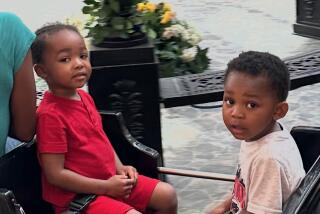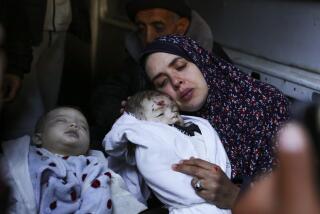Conjoined Iranian Twins Die After Two-Day Surgery
- Share via
Tehran — In a nation where the disabled are often viewed more with disdain than compassion, Laleh and Ladan Bijani became unlikely heroes.
Joined at the head since birth, the Iranian twins’ plight had long been followed by the public with impertinent curiosity. But the 29-year-olds’ decision to embark on an extremely risky separation operation in Singapore for the chance at independent lives provoked an outpouring of sympathy for the women and transfixed their homeland.
When the operation -- the first attempt ever to separate adult twins joined at the head -- failed Tuesday after more than two days of surgery, the news plunged Iran into mourning.
Many Iranians who had come to see the women as symbols of perseverance in the face of extraordinary physical and emotional hardship reached for their mobile phones to share their grief with family and friends.
“Their whole story struck a chord with me, though I can’t explain why it’s more sad than anyone innocent dying,” said Maryam Hosseini, a travel agent in Tehran.
Despite the challenges of the operation, Iranian media reports had suggested that at least one sister would survive. Newspapers filled pages with stories and photos documenting how the twins coped with their lives, and state TV broadcast a home video of the two behind the wheel of a car, both lodged in the driver’s seat. Radio stations aired updates on the hour.
Before the operation began Sunday at Singapore’s Raffles Hospital, Iranian President Mohammad Khatami offered his best wishes. “I hope to see the dear and patient Laleh and Ladan healthy and happy among us very soon,” he said. Khatami’s office said it would cover the approximate $300,000 cost of the surgery.
The sisters struggled to lead a normal life throughout their 20s, attending college and eventually living on their own. They wore makeup, socialized and talked about their professional goals. Wearing the mandatory Islamic veil posed a physical challenge, which they met by wrapping a scarf around both their heads and securing it underneath with a clip.
Although they had adapted to their situation, the women had for years been seeking doctors who would be willing to try to separate them. Such surgery has been successfully completed on infants -- whose brains are considered more malleable than adult brains and recover from injury better -- but it had never been attempted on adults.
In 1996, the twins consulted German doctors but were turned down. Although they had separate brains, they shared a major blood vessel, the venous sinus, which drains blood from the brain. The doctors felt the shared vein made the surgery too risky.
The women sought out doctors in Singapore after conjoined Nepalese infants were separated there in 2001. Following a long battery of tests and psychological examinations, the Bijani sisters were accepted once doctors determined that there was a reasonable chance they could survive -- and that remaining fused could pose other health risks.
Before the surgery, the Singapore team -- a group of 28 specialists from Singapore, the U.S., Nepal, Japan, France and Switzerland -- knew it would have to give the venous sinus to one of the twins and construct a second blood vessel for the other twin.
In their last public statement before the surgery, the twins said, “If God wants us to live the rest of our lives as two separate, independent individuals, we will.”
But from the start, the surgery proved more difficult than expected. The section of skull that joined the twins was thicker and more compact than doctors anticipated, and the six-hour surgery to cut away the skull and reveal the brains ran longer than surgeons projected.
After cutting away a thick strip of bone from the front of the shared skull, surgeons were able to closely examine the brains and blood vessels and determined that Ladan would receive the new blood vessel. They began constructing a new vessel for her using a vein removed from her right thigh.
The procedure was completed Monday at 4:30 p.m. Singapore time, and the surgery to separate the brains began. Doctors found that while the brains were separate, they had adhered to each other. Surgeons had to separate them millimeter by millimeter, a process that lasted through the night.
At 1:20 p.m. Tuesday, the separation was nearly complete, and the twins were declared to be in stable condition. However, the loss of blood in the concluding hours of the surgery proved too great. Ladan died just after 2:30 p.m. Laleh was listed as critically ill and, though doctors fought to stabilize her, she died an hour and a half later.
Dr. Steven Chang, an assistant professor of neurosurgery at Stanford who did not take part in the operation, said that although the loss of blood was the main problem, it probably led to swelling, which was most likely the cause of death.
“I think the death was a combination of difficulty with bleeding, but also brain swelling,” Chang said. Blood loss in the brain, he said, is not like blood loss from a cut -- rather than just bleeding, the brain swells up like a sponge.
“If I were their neurosurgeon, I would have told them that their likelihood of not surviving the surgery was at least 50%,” Chang said.
Dr. Keith Goh of Raffles Hospital, one of the lead neurosurgeons, said while he had initially tried to talk the sisters out of the surgery, he came to understand their suffering.
“I was very saddened,” a weary Goh said after the women died. “I saw them struggling -- of course, at the same time, we were struggling too.”
As the twins neared 30, their physical attachment was severely obstructing their personal ambitions for individual careers and a family life. Both studied law at a university, but Laleh had said she wanted to become a journalist if they were separated.
The prospect of marriage posed a particular conundrum. Alireza Safaian, the twins’ adopted father, took them several times to visit Ayatollah Ruhollah Khomeini, Iran’s former supreme leader, who died in 1989. On one visit, he asked Khomeini how Laleh and Ladan could be married. The ayatollah, who guided Muslims in gray areas of religious observance, said because they were two distinct women, they must marry two men -- ideally brothers.
The twins’ birth parents, Dadollah Bijani and Maryam Safari, have eight other children and live a quiet life without even a telephone in the city of Shiraz. After Safari gave birth to the twins, she chose not to bring them home.
The sisters lived in a hospital in Shiraz until they were 5, when Safaian adopted them.
Two years ago, the biological parents came to Tehran, where Laleh and Ladan were living. That reunion soured the sisters’ relationship with their adoptive parents. Safaian said he learned of their decision to undergo surgery in the newspapers.
“They didn’t tell me. They never talked to us about it, so that we could stop them,” he said. “I knew they would die.”
As news of their death spread, some Iranians struggled to understand why the sisters would embark on the operation. “You’d think after so many years attached, they would have adapted to living that way,” said Shahla Hekmat, a homemaker.
But others sought solace in the fact that the sisters who were joined in life were together in death.
“Maybe it’s better that they both died,” said Ali Hashemi, a shoe store owner in Tehran. “Because if one had survived, she’d have felt guilty for the rest of her life.”
Moaveni reported from Tehran and Heinrichs from Los Angeles.
More to Read
Sign up for Essential California
The most important California stories and recommendations in your inbox every morning.
You may occasionally receive promotional content from the Los Angeles Times.













